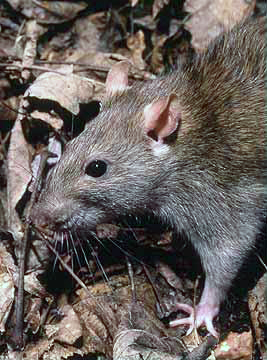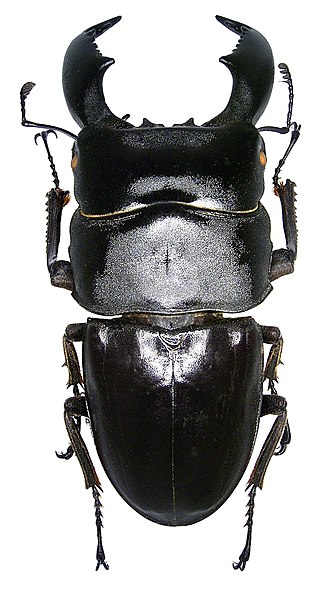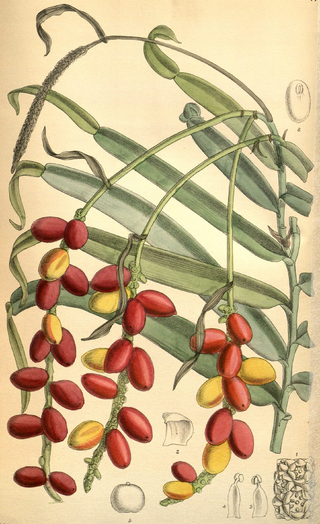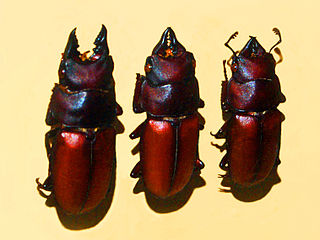Related Research Articles

Rattus is a genus of muroid rodents, all typically called rats. However, the term rat can also be applied to rodent species outside of this genus.

Mallotus is a genus of the spurge family Euphorbiaceae first described as a genus in 1790. Two species are found in tropical Africa and Madagascar, while all others are found in East Asia, the Indian Subcontinent, Southeast Asia, eastern Australia, and certain islands of the western Pacific. The genus has about 150 species of dioecious trees or shrubs.

Gasteracantha is a genus of orb-weaver spiders first named by Carl Jakob Sundevall in 1833. Species of the genus are known as spiny-backed orb-weavers, spiny orb-weavers, or spiny spiders. The females of most species are brightly colored with six prominent spines on their broad, hardened, shell-like abdomens. The name Gasteracantha is derived from the Greek gaster (γαστήρ), meaning "belly, abdomen", and akantha (άκανθα), meaning "thorn, spine". Spiny-backed orb-weavers are sometimes colloquially called "crab spiders" because of their shape, but they are not closely related to the true crab spiders. Other colloquial names for certain species include thorn spider, star spider, kite spider, or jewel spider.

Cleistanthus is a plant genus of the family Phyllanthaceae, tribe Bridelieae, first described as a genus in 1848. It is widespread in much of the Old World Tropics in Asia, Africa, Australia, and various oceanic islands. Cleistanthus collinus is known for being toxic and may be the agent of homicides or suicides.

Dorcus is a genus of beetles in the stag beetle family Lucanidae. Of the over 100 species, most occur in Asia and India; two are found in southern Europe, and two species are from North America. Previously, specimens with serriform teeth on the mandibles and sable pigment were called Serrognathus whereas specimens with but a singular or multiple bulky notches on the mandibles and lustrous sable pigmentation were called Dorcus.

Chionanthus, common name: fringetrees, is a genus of about 140 species of flowering plants in the family Oleaceae.

Serrognathus titanus is a species of beetle in the family Lucanidae. It was described by Jean Baptiste Boisduval in 1835. Huang and Chen (2013) separated Serognathus from the genus Dorcus by representing morphological characters and DNA analysis.

Pothos is a genus of flowering plants in the family Araceae. It is native to China, the Indian Subcontinent, Australia, New Guinea, Southeast Asia, and various islands of the Pacific and Indian Oceans.

Podoctidae is a family of the harvestman infraorder Grassatores with about 130 described species.
Asota heliconia is a moth in the family Erebidae. It is found from the Indo-Australian tropics east to Queensland and the Solomons.

Batocera is a genus of the family Cerambycidae, subfamily Lamiinae, close to the genus Rosenbergia.

Meganoton rubescens, the rosy double-bristled hawkmoth, is a moth of the family Sphingidae. It is known from north-eastern India, central and northern Thailand, southern China, northern Vietnam, Malaysia, Indonesia, the Philippines, Papua New Guinea, northern Australia and the Solomon Islands.

Cyclommatus is a genus of the family Lucanidae, also known as the stag beetle. The majority of the species from the genus Cyclommatus are located in Southeast Asia, though some species are found in China and Taiwan as well. The genus Cyclommatus also consists of three subgenera: Cyclommatus, Cyclommatinus and Cyclommatellus. Each subgenera contains 80, 24 and 3 species respectively. In total, the genus Cyclommatus consists of a total of 134 species, though more are still being discovered to this day.

Odontolabis is a genus of beetles belonging to the family Lucanidae.

Prosopocoilus is a genus of beetles of the family Lucanidae.

Omoglymmius is a genus in the ground beetle subfamily Rhysodinae. There are more than 150 described species in Omoglymmius, found on every continent except Antarctica.

Thelyphonus is the type genus of whip scorpions or 'vinegaroons' in the subfamily Thelyphoninae, with species found in Southeast Asia.
Epania is a genus of longhorn beetles in the family Cerambycidae. There are more than 60 described species in Epania, found mainly in Southeast Asia, but also in southern and eastern Asia, and Australia.
References
- 1 2 "Figulus Macleay, 1819". Catalogue of Life. Retrieved 2024-08-17.
- ↑ "Figulus". GBIF. Retrieved 2024-08-17.